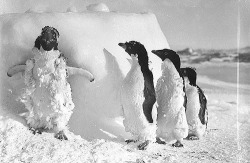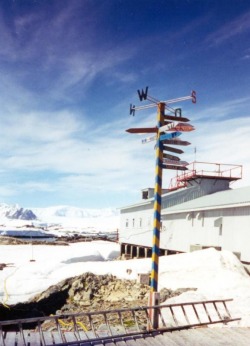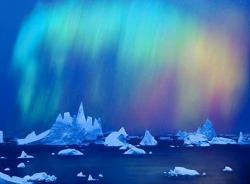Unique Characteristics
Climate

Penguins after a Blizzard
Antarctica is a huge continent that is twice the size of Australia. It is 98% covered in snow and ice and the average temperature is -49 degrees! The coldest temperature ever recorded was -89 on July 21st 1983. The winds in Antarctica can blow at over 300 kilometres per hour! This is about the speed of a catergory five cyclone. Antarctica is the coldest and windiest continent in the world. Although this sounds wierd, Antarctica is technically a desert! The last rainfall recorded in Antarctica was about 2000 years ago. Although most animals in the Antarctic have protection from the harsh climate, severe blizzards in Antarctica can be fatal. In the picture to the left, it portrays three Adelie Penguins that survived after a blizzard. The fourth penguin obviously wasn't so lucky.
Vegetation

Hair Grass
The extreme climate here makes Antarctica a habitat in which only the hardiest of species can survive. In the whole of Antarctica, there are only two types of plants which can survive the freezing conditions. These two are the Hair Grass and a cushion-forming pearlwort. The Hair Grass and Perlwort grow in clumps near the shore of the West Coast. Both these plants can tolerate very cold and dry conditions.
Human Occupancy

A Research Base in Antractica
Most of the people living in Antarctica today are scientists who live in research bases which are situated in most places around Antarctica. The Antarctic treaty that was signed in 1960 certifies that Antarctica can only be used for peaceful scientific research. No military personnel are allowed, no mining and no animals. This is why there are no longer sled dogs residing in Antarctica. There are no eskimos living in Antarctica as it is much too cold.
Aurora Australis

Aurora Australis
This is a fantastic light display that only happens in Antarctica and The Arctic. It is called Aurora Australis in the South and Aurora Borealis in the North. You can only see Aurora Australis in winter. This is because that is when highly charged electrons from the wind join with the earth's elements and mix together to create this amazing exhibition. Aurora Australis usually lasts one to two hours. A very faint Aurora might only last only a few minutes. Some of the really strong Aurora Australis's can even last a few days. Many people would love to see this rare spectacle but most are unwilling as you can only see Aurora Australis in the dead of winter and Antarctica, as you know, can be life threating in this season due to freezing conditions.
